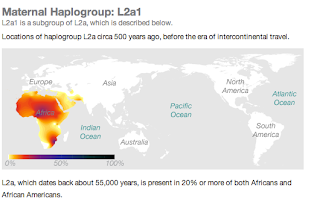So far with 23andme, I have been able to test 7 people in my family including myself and have been able to discover 4 different maternal haplogroups. What’s interesting about our haplogroups is that they aren’t from just one area- with the migration to Puerto Rico coming from many different areas and for many different reasons, our maternal heritage (just like our paternal heritage) tells many different stories. But the one I want to focus on mainly today is my great grandfather’s European haplogroup U5b1b1b. First I’ll talk quickly about the others.
My own personal maternal haplogroup came as a nice surprise to me when I first tested in 2009. When I got my results I was able to see that my maternal haplogroup was the indigenous C1b4. This group as you can see below is present in both Asia and the Americas. My guess is that somewhere along my maternal ancestress’ line I descend from a Taíno/Arawak woman.
Similarly, another group found on the maternal side of the family that is also connected to Native Americans is called A2. A2 has a higher concentration up in North America near the Bering Strait. However, you can also see that it is evenly common and widespread throughout Central and Southern America. Again, this haplogroup was most likely introduced to my family through a Taíno/Arawak ancestress.
Found on my paternal side of the family is the only African Haplogroup I’ve discovered so far called L2a1. This haplogroup is found amongst African Americans seeing as how it is commonly found in Sub-Sahara Africa amongst the Bantu-speakers. Since it is so widespread it is difficult to pinpoint exactly where in Africa my ancestress would have originated from. Some speculate that its origin lies somewhere in Central Africa. Due to the Atlantic Slave Trade, many L2a1 carrying women entered areas such as the Caribbean, South America and North America which is why it is so commonly found there. I have not been able to figure out who my original L2a1 African born ancestress was, but hopefully one day I’ll be able to know more about this line and haplogroup.
Lastly, my great grandfather is the only one in my family tested so far to carry a European haplogroup yet with an interesting history. His maternal haplogroup is known as U5b1b1b and can be found amongst the Basque and even amongst the Saami population in Northern Scandinavia.
U5b1b1b is part of the branch U5 which “arose among early colonizers of Europe around 40,000 years ago”. But what’s more interesting about this group is that is seems to have made its way back into Africa via Northern Africa where it can be found amongst people in Morocco and even as far south as Senegal. The big question for me is: Where did my U5b1b1b ancestress come from herself? Did she live in southern Spain before heading off to Puerto Rico? Was she a Moroccan woman who’s family found their way to Spain and settled in Al-Andalus? Or was she just a European woman who’s husband decided to head to the Caribbean and she agreed to the journey?
So far any of these stories and many others are possible. What’s interesting is that my great grandfather does carry, according to Ancestry Composition, North African genes. Pictured below is his Chromosome 4 on “Standard Estimate” and the dark blue on the top is the North African he carries. There is a smaller chunk of it as well on Chromosome 7. Who he receives these genes from is still a mystery to me! Also in Ancestry Finder he receives a match with all 4 grandparents born in Morocco.
| Chromosome 4- North African Genes |
 |
| Chromosome 7- North African Genes |
 |
| Chromosome 2- Moroccan Match |
Hopefully one day I’ll be able to name who these women were and talk about the lives they would have lived!




